
The Gulf of California is a marginal sea of the Pacific Ocean that separates the Baja California Peninsula from the Mexican mainland. It is bordered by the states of Baja California, Baja California Sur, Sonora, and Sinaloa with a coastline of approximately 4,000 km (2,500 mi). Rivers which flow into the Gulf of California include the Colorado, Fuerte, Mayo, Sinaloa, Sonora, and the Yaqui. The surface of the Gulf is about 160,000 km2 (62,000 sq mi). Depths range from near-zero at its fording at the estuary near Yuma, Arizona, to in excess of 3,000 meters (9,800 ft) due to the complex geology, linked to Plate Tectonics.
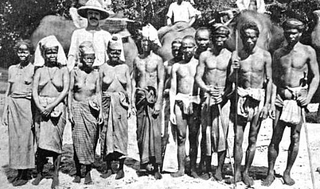
The Negrito are several diverse ethnic groups who inhabit isolated parts of Southeast Asia and the Andaman Islands. Their current populations include: the Andamanese peoples of the Andaman Islands, the Semang peoples of Peninsular Malaysia, the Maniq people of Southern Thailand, as well as the Aeta, Ati, and about 30 other officially recognized ethnic groups in the Philippines.

The Revillagigedo Islands or Revillagigedo Archipelago are a group of four volcanic islands in the Pacific Ocean, known for their unique ecosystem. They lie approximately 285 miles (458 km) from Socorro Island south and southwest of Cabo San Lucas, the southern tip of the Baja California Peninsula, and 698 to 1,092 kilometres west of Manzanillo. They are located around 18°49′N112°46′W. Technically part of the Mexican state of Colima, the islands are under Mexican federal jurisdiction.

The Jason Islands are an archipelago in the Falkland Islands, lying to the far north-west of West Falkland. Three of the islands, Steeple Jason, Grand Jason and Clarke's Islet, are private nature reserves owned by the Wildlife Conservation Society of New York City. Other islands in the group are National Nature Reserves owned by the Falkland Islands Government.
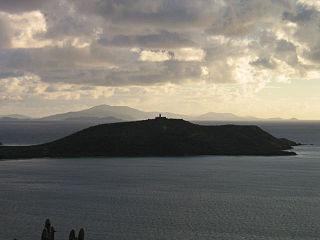
Isla Culebrita is a small, uninhabited island off the eastern coast of Culebra, Puerto Rico and is part of the Puerto Rico Archipielago. Together with Cayo Botella off the northwestern point, and Pelá and Pelaita to the west, it belongs to the barrio Fraile of Culebra. It is a nature reserve and is part of the Culebra National Wildlife Refuge. The island is home to Culebrita Lighthouse, one of the oldest lighthouses in the Caribbean. Culebrita is only accessible by private boat from the main island of Culebra.
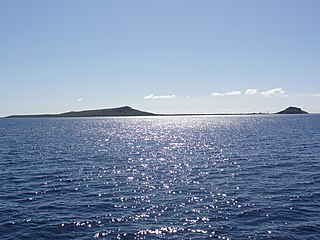
Caja de Muertos is an uninhabited island off the southern coast of Puerto Rico, in the municipality of Ponce. The island is protected by the Reserva Natural Caja de Muertos natural reserve, because of its native turtle traffic. Hikers and beachgoers are often seen in the island, which can be reached by ferry from the La Guancha Boardwalk sector of Ponce Playa. Together with Cardona, Ratones, Morrillito, Isla del Frio, Gatas, and Isla de Jueyes, Caja de Muertos is one of seven islands ascribed to the municipality of Ponce.

Filipinos are the people who are native to or citizens of the country of the Philippines. Filipinos come from various Austronesian ethnolinguistic groups. Currently, there are more than 185 ethnolinguistic groups in the Philippines; each with its own language, identity, culture and history. The number of individual languages listed for Philippines is 185. Of these, 183 are living and 2 are extinct. Of the living languages, 175 are indigenous and 8 are non-indigenous. Furthermore, as of 2019, 39 are institutional, 67 are developing, 38 are vigorous, 28 are endangered, and 11 are dying.
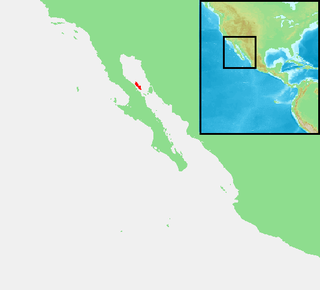
Isla Ángel de la Guarda, also called Archangel Island, is a large island in the Gulf of California east of Bahía de los Ángeles in northwestern Mexico, separated from the Baja California Peninsula by the Canal de Ballenas. It is the second largest of the eleven Midriff Islands or Islas Grandes. It is part of the state of Baja California, located northwest of Tiburón Island. The island is uninhabited, and is a biological reserve called Isla Angel de la Guarda National Park. The island is part of the Mexicali municipality.
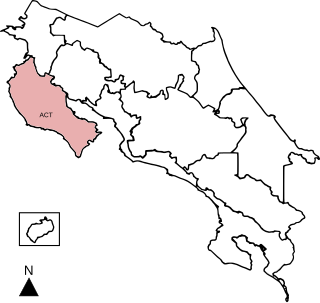
Tempisque Conservation Area is an administrative area which is managed by SINAC for the purposes of conservation in the western part of Costa Rica, including the Tempisque River valley and the Nicoya Peninsula. It contains a number of National Parks, Wildlife refuges and Forest Reserves.
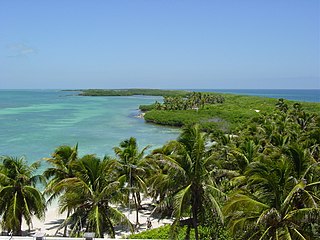
Isla Contoy is a small island in the Mexican state of Quintana Roo, approximately 30 kilometers north of Isla Mujeres. The island is only 8.5 km (5.3 mi) in length and has an area of 3.17 square kilometres (1.22 sq mi).

The Islas Marías are an archipelago of four islands that belong to Mexico. They are located in the Pacific Ocean, some 100 km (62 mi) off the coast of the state of Nayarit and about 370 km (230 mi) southeast of the tip of Baja California. They are part of the municipality (municipio) of San Blas, Nayarit. The islands were used as a penal colony until February 18th of 2019 when President Andres Manuel Lopez Obrador ordered the closure of its operation as Islas Marías Federal Prison.

Morrillito is a small uninhabited island off the southern coast of Puerto Rico. The island is protected by the Reserva Natural Caja de Muertos natural reserve because of its native turtle traffic. Together with Caja de Muertos, Gatas, Ratones, Cardona, Isla del Frio, and Isla de Jueyes, Morrillito is one of seven islands ascribed to the municipality of Ponce.

Isla de Ratones is a small uninhabited island off the southern coast of Puerto Rico, off the coast of Ponce. The island is part of barrio Canas in the municipality of Ponce. The island gained attention in 2010 when the Puerto Rican Bird Society made it a target for the eradication of the black rat. While named as one single island, it is actually composed of two islands separated by a few feet of shallow water during high tide, which become a single island at low tide.
Protected areas of Panama include:

The Islas MaríasBiosphere Reserve is a UNESCO Biosphere Reserve located in the Islas Marías in the municipality (municipio) of San Blas, Nayarit, Mexico. The 641,284.73 hectares (2,476.0142 sq mi) reserve includes ecosystems with a great wealth of species of biological, economic, scientific and cultural relevance. Its biological wealth is to be found in the dry forests of its landscape, in the mangroves, the succulent rosette scrubland, the reefs, coasts and pelagic environments it harbors.
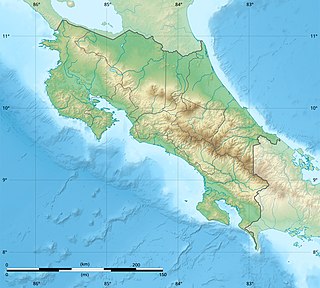
Guayabo Island Biological Reserve, is a protected area in Costa Rica, managed under the Tempisque Conservation Area, it was created in 1973 by executive decree 2858-A DEL.

Pájaros Island Biological Reserve, is a protected area in Costa Rica, managed under the Central Pacific Conservation Area, it was created in 1976 by decree 5963-A.














